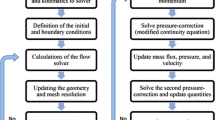Abstract
The flapping foil based on bionics is a sort of simplified models which imitate the motion of wings or fins of fish or birds. In this paper, a universal kinematic model with three degrees of freedom is adopted and the motion parallel to the flow direction is considered. The force coefficients, the torque coefficient, and the flow field characteristics are extracted and analyzed. Then the propulsive efficiency is calculated. The influence of the motion parameters on the hydrodynamic performance of the bionic foil is studied. The results show that the motion parameters play important roles in the hydrodynamic performance of the flapping foil. To validate the reliability of the numerical method used in this paper, an experiment platform is designed and verification experiments are carried out. Through the comparison, it is found that the numerical results compare well with the experimental results, to show that the adopted numerical method is reliable. The results of this paper provide a theoretical reference for the design of underwater vehicles based on the flapping propulsion.
Similar content being viewed by others
References
Wu T. Y. Fish swimming and bird/insect flight [J]. Annual Review of Fluid Mechanics, 2011, 43: 25–58.
Tang C., Lu X. Y. Self-propulsion of a three-dimensional flapping flexible plate [J]. Journal of Hydrodynamics, 2016, 28(2): 1–9.
Han R., Zhang J., Cao L. et al. Propulsive performance of a passively flapping plate in a uniform flow [J]. Journal of Hydrodynamics, 2015, 27(4): 496–501.
Hu J., Xiao Q. Three-dimensional effects on the transla-tional locomotion of a passive heaving wing [J]. Journal of Fluids and Structures, 2014, 46: 77–88.
Cheng H. Y., Long X. P, Ji B. et al. Numerical investiga-tion of unsteady cavitating turbulent flows around twisted hydrofoil from the Lagrangian viewpoint [J]. Journal of Hydrodynamics, 2016, 28(4): 709–712.
Liu W., Li N., Zhao J. et al. Wake structure and hydrody-namic performance of flapping foils mimicking fish fin kinematics [J]. Saudi Journal of Biological Sciences, 2017, 24(6): 1344–1354.
Szymik B. G., Satterlie R. A. Changes in wingstroke kinematics associated with a change in swimming speed in a pteropod mollusk, Clione limacine [J]. The Journal of Experimental Biology, 2011, 214(23): 3935–3947.
Licht S. C., Wibawa M. S., Hover F. S. et al. In-line motion causes high thrust and efficiency in flapping foils that use power downstroke [J]. The Journal of Experi-mental Biology, 2010, 213(1): 63–71.
Tobalske B. W., Warrick D. R., Clark C. J. et al. Three-dimensional kinematics of hummingbird flight [J]. The Journal of Experimental Biology, 2007, 210(13): 2368–2382.
Dileo C., Deng X. Design of and experiments on a dragonfly-inspired robot [J]. Advanced Robotics, 2009, 23: 1003–1021.
Berg A. M., Biewener A. A. Wing and body kinematics of takeoff and landing flight in the pigeon (Columba livia) [J]. The Journal of Experimental Biology, 2010, 213(10): 1651–1658.
Lindhe Norberg U. M., Winter Y. Wing beat kinematics of a nectar-feeding bat, Glossophaga soricina, flying at diffe-rent flight speeds and Strouhal numbers [J]. The Journal of Experimental Biology, 2006, 209(19): 3887–3897.
Izraelevitz J. S., Triantafyllou M. S. Adding in-line motion and model-based optimization offers exceptional force control authority in flapping foils [J]. Journal of Fluid Mechanics, 2014, 742: 5–34.
Zhou K., Liu J., Chen W. Numerical study on hydrody-namic performance of bionic caudal fin [J]. Applied Sciences-Basel, 2016, 6(1): 15.
Xia D., Chen W., Liu J. et al. The three-dimensional hy-drodynamics of thunniform swimming under self-pro-pulsion [J]. Ocean Engineering, 2015, 110: 1–14.
Bhalla A. P. S., Griffith B. E., Patankar N. A. A forced damped oscillation framework for undulatory swimming provides new insights into how propulsion arises in active and passive swimming [J]. PLOS Computational Biology, 2013, 9(6): e1003097.
Neveln I. D., Bale R., Bhalla A. P. S. et al. Undulating fins produce off-axis thrust and flow structures [J]. Journal of Experimental Biology, 2014, 217(2): 201–213.
Bhalla A. P. S., Bale R., Griffith B. E. et al. A unified mathematical framework and an adaptive numerical method for fluid–structure interaction with rigid, defor-ming, and elastic bodies [J]. Journal of Computational Physics, 2013, 250: 446–476.
Taylor G. K., Nudds R. L., Thomas A. L. R. Flying and swimming animals cruise at a Strouhal number tuned for high power efficiency [J]. Nature, 2003, 425: 707–711.
Thomas A. L. R., Taylor G. K., Srygley R. B. et al. Dragonfly flight: Free-flight and tethered flow visualiza-tions reveal a diverse array of unsteady lift-generating mechanisms, controlled primarily via angle of attack [J]. Journal of Experimental Biology, 2004, 207(24): 4299–4323.
Acknowledgement
This work was supported by the State Key Laboratory of independent topics, Harbin Institute of Technology (Grant No. SKLRS200801C).
Author information
Authors and Affiliations
Corresponding author
Additional information
Project supported by the National Natural Science Foundation of China (Grant No. 50905040).
Biography: Kai Zhou (1987-), Male, Ph. D., Lecturer
Rights and permissions
About this article
Cite this article
Zhou, K., Liu, Jk. & Chen, Ws. Numerical and experimental studies of hydrodynamics of flapping foils. J Hydrodyn 30, 258–266 (2018). https://doi.org/10.1007/s42241-018-0028-3
Received:
Accepted:
Published:
Issue Date:
DOI: https://doi.org/10.1007/s42241-018-0028-3




